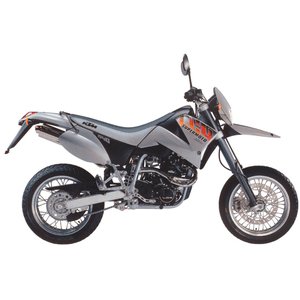KTM 640 Supermoto LC4 [2005–2007]: A Rowdy Supermoto That Still Thrills
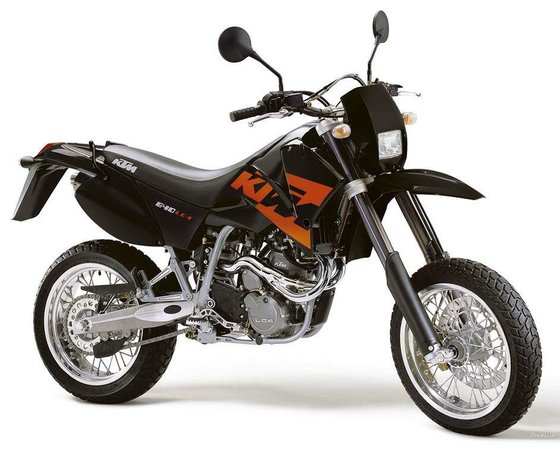
Introduction
The KTM 640 Supermoto LC4 isn’t just a motorcycle—it’s a declaration of rebellion. Built for riders who crave the agility of a dirt bike with the precision of street rubber, this Austrian machine from 2005–2007 remains a cult classic. With its snarling single-cylinder engine, race-bred suspension, and minimalist design, the 640 Supermoto is a reminder of an era when motorcycles prioritized raw fun over digital gimmicks. Having recently thrown a leg over a well-maintained 2006 model, I can confirm: this bike hasn’t lost an ounce of its charm. Let’s dive into what makes it tick—and why it still turns heads today.
Design & Ergonomics: Form Follows Function
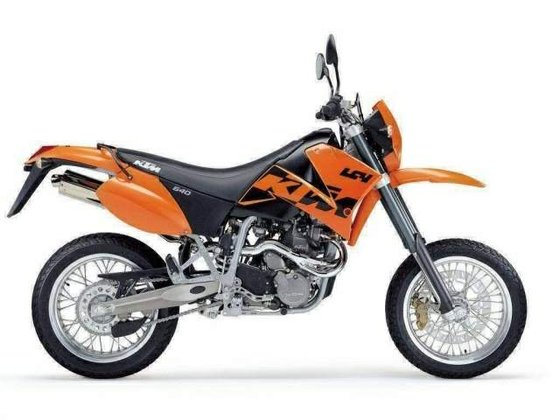
KTM’s design philosophy for the 640 Supermoto LC4 is unapologetically utilitarian. The chromoly steel frame is left unpainted, showcasing its purposeful construction, while the sharp, angular bodywork comes in bold “KTM Orange” or stealthy black. At 910 mm (35.8 inches), the seat height is towering, demanding confidence (or long legs) from its rider. Yet, the narrow seat profile and 149 kg (328.5 lbs) dry weight make it surprisingly manageable once moving.
Standout features include the burly 48 mm WP USD forks, a high-mounted front fender, and 17-inch wheels wrapped in sticky road tires (120/70 front, 160/60 rear). The LCD dashboard is basic by modern standards, but it delivers essential info without clutter. Ground clearance sits at 280 mm (11 inches), a nod to its dirt-ready DNA—though you’ll want to keep this one on paved twisties.
Engine Performance: Single-Cylinder Savagery
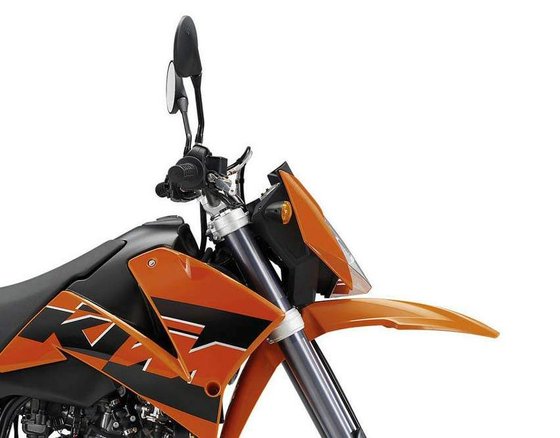
The 625 cc LC4 engine is the star of the show. This liquid-cooled single-cylinder thumper punches out 53.6 HP at 6,750 RPM and a meaty 60 Nm (44.3 lb-ft) of torque at 5,750 RPM. Carbureted by a Mikuni BST 40, it’s a visceral experience: the throttle response is immediate, and the exhaust barks with a metallic snarl that’s pure KTM.
On the road, the power delivery is punchy but manageable. The LC4 thrives between 4,000–7,000 RPM, pulling hard out of corners and rewarding aggressive shifts from its 5-speed gearbox. The hydraulic clutch is light, and the chain final drive (17/42 sprockets) ensures minimal power loss.
Weak spot? Vibration. At highway speeds, the single-cylinder’s buzz numbs your hands, reminding you this isn’t a touring machine. But for short blasts or urban hooliganism, it’s a small price to pay for the adrenaline rush.
Handling & Ride Experience: Born for Corners
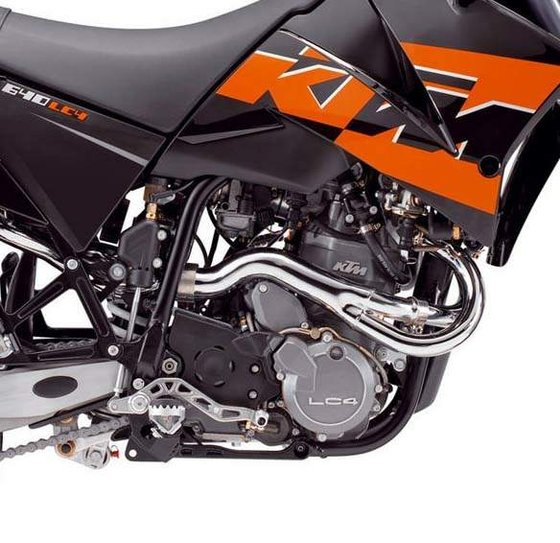
If you’ve ever dreamt of treating public roads like a Supermoto racetrack, the 640 LC4 is your enabler. The WP suspension—48 mm forks up front and a Pro-Lever-linked monoshock at the rear—is stiff yet compliant, absorbing bumps while keeping the chassis poised during aggressive leans. With a 27-degree rake and 99 mm (3.9 inches) of trail, the steering is razor-sharp.
Flicking the bike through hairpins feels effortless, thanks to the lightweight chassis and knuckle-friendly 1510 mm (59.4-inch) wheelbase. Braking is handled by a single 320 mm front disc (4-piston caliper) and a 220 mm rear disc—adequate for the bike’s weight, though aftermarket pads are a wise upgrade for track use.
Pro tip: Run the tire pressures at 2.0–2.2 bar (29–32 PSI) front and 2.2–2.4 bar (32–35 PSI) rear for optimal grip.
Competition: How Does the KTM Stack Up?
In the mid-2000s supermoto arena, the 640 LC4 faced fierce rivals:
-
Husqvarna SM610
Similar specs (576 cc single, ~50 HP), but the Husky’s 6-speed gearbox and smoother fuel injection gave it an edge on longer rides. However, the KTM’s suspension and aftermarket support were superior. -
Aprilia SXV 5.5
Aprilia’s 549 cc V-twin screamed to 70 HP, but its complex engine demanded religious maintenance. The KTM’s LC4, while less powerful, was far more reliable. -
Honda XR650M
Honda’s offering was bulletproof but heavier (163 kg) and tuned for off-road plodding. The KTM dominated in agility and street-focused aggression.
Verdict: The 640 LC4 struck a balance between power, weight, and durability. It wasn’t the fastest or the fanciest, but it was (and still is) the most alive.
Maintenance: Keeping the LC4 Healthy
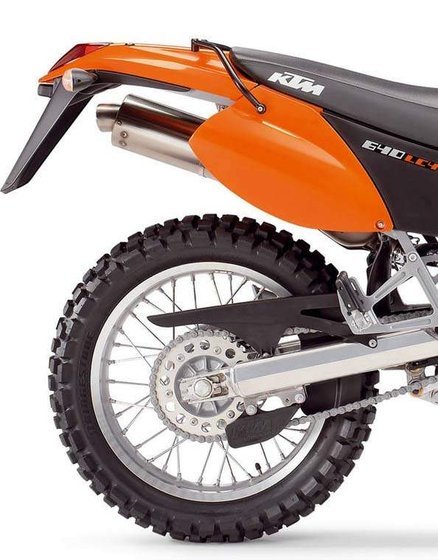
Owners swear by the LC4’s simplicity, but neglect is a one-way ticket to repairs. Here’s your cheat sheet:
- Valve Adjustments: Every 15,000 km (9,300 miles). Intake/Exhaust: 0.12–0.15 mm (0.0047–0.0059 in).
- Oil Changes: Use JASO T903 MA-rated 10W/50 oil. Capacity: 2.1L (2.2 quarts) with filter.
- Carb Tuning: The Mikuni BST 40 loves attention. Set the air screw to 2.25 turns out and clean the jets annually.
- Chain Care: The 5/8 x 1/4" X-ring chain lasts longer with regular lubrication. Replace sprockets if teeth hook.
- Cooling System: Flush with fresh DOT 4 coolant every 2 years.
MOTOPARTS.store Recommendations:
- Upgrade to NGK DCPR8EIX iridium spark plugs for smoother starts.
- Install a DID 520VX3 chain for durability.
- Swap stock brake pads for sintered alternatives.
Conclusion: A Timeless Supermoto Icon
The KTM 640 Supermoto LC4 isn’t for everyone. It’s loud, vibey, and demands a rider who’s ready to work for their fun. But for those who click with its personality, it’s a revelation. Few bikes from the mid-2000s offer this level of engagement—a reminder that riding should be about skill, not just speed.
Whether you’re carving canyon roads or hunting for garage projects, the 640 LC4 rewards passion. And with MOTOPARTS.store’s catalog of upgrades, you can keep this orange beast roaring for another decade.
Stay tuned for our next review, and keep your throttle twisted.
Specifications sheet
| Engine | |
|---|---|
| Stroke: | Four-stroke |
| Max power: | 40 kW | 54.0 hp |
| Max torque: | 60 Nm |
| Fuel system: | Mikuni BST 40 carburetor |
| Max power @: | 7500 rpm |
| Displacement: | 625 ccm |
| Max torque @: | 5750 rpm |
| Bore x stroke: | 101.0 x 78.0 mm (4.0 x 3.1 in) |
| Configuration: | Single |
| Cooling system: | Liquid |
| Compression ratio: | 11.7:1 |
| Number of cylinders: | 1 |
| Valves per cylinder: | 4 |
| Dimensions | |
|---|---|
| Wheelbase: | 1510 mm (59.4 in) |
| Dry weight: | 149 |
| Seat height: | 915 mm (36.0 in) |
| Ground clearance: | 280 mm (11.0 in) |
| Fuel tank capacity: | 11.2 L (3.0 US gal) |
| Reserve fuel capacity: | 2.5 L (0.7 US gal) |
| Drivetrain | |
|---|---|
| Chain type: | 5/8 x 1/4" X-ring |
| Final drive: | chain |
| Gear ratios: | 1st 14:35, 2nd 15:24, 3rd 18:21, 4th 20:19, 5th 22:18 |
| Transmission: | 5-speed |
| Rear sprocket: | 42 |
| Front sprocket: | 17 |
| Primary drive ratio: | 30:81 |
| Electrical | |
|---|---|
| Battery: | 12V 8Ah (maintenance-free) |
| Ignition system: | Kokusan DC-CDI |
| Maintenance | |
|---|---|
| Rear tire: | 160/60-17 |
| Engine oil: | 10W50 |
| Front tire: | 120/70-17 |
| Idle speed: | 1500 ± 100 RPM |
| Brake fluid: | DOT 4 |
| Spark plugs: | NGK DCPR8E or NGK DCPR8EIX |
| Spark plug gap: | 0.6 |
| Coolant capacity: | 1.0 |
| Engine oil capacity: | 2.1 |
| Valve clearance (intake, cold): | 0.12–0.15 mm |
| Valve clearance (exhaust, cold): | 0.12–0.15 mm |
| Recommended tire pressure (rear): | 2.2 bar (32 psi) solo, 2.4 bar (35 psi) with passenger |
| Recommended tire pressure (front): | 2.0 bar (29 psi) normal, 2.2 bar (32 psi) loaded |
| Chassis and Suspension | |
|---|---|
| Frame: | Chromium-molybdenum steel twin-spar |
| Trail: | 99 mm (3.9 in) |
| Rear brakes: | Single 220 mm disc, 1-piston caliper |
| Front brakes: | Single 320 mm disc, 4-piston caliper |
| Rear suspension: | WP monoshock with Pro-Lever linkage |
| Front suspension: | WP USD 48 mm inverted fork |
| Rake (fork angle): | 27.0° |
| Rear wheel travel: | 300 mm (11.8 in) |
| Front wheel travel: | 270 mm (10.6 in) |



